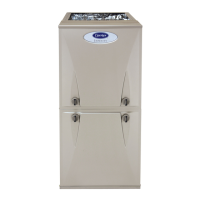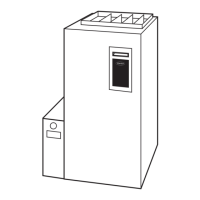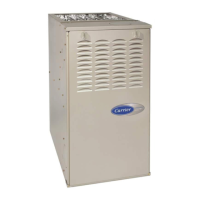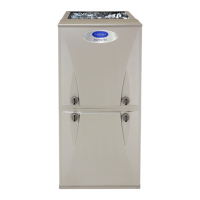Do you have a question about the Carrier Infinity 59TN6A and is the answer not in the manual?
Highlights key features like Infinity System compatibility, ENERGY STAR compliance, quiet operation, and cabinet dimensions.
Outlines the warranty period for parts and heat exchanger, including conditions and registration requirements.
Explains Comfort Heat, Ideal Humidity, SmartEvap, and ComfortFan technologies for enhanced home comfort and efficiency.
Details HYBRID HEAT, Power Heat Igniter, variable speed motors, and multipoise design for flexible installation and performance.
Covers heat exchanger design, media filter cabinet, sealed combustion, insulated casing, and quality certifications.
Provides input/output BTUH, AFUE ratings, and temperature rise ranges for various furnace models.
Lists external static pressure, airflow delivery (CFM), motor specifications, and blower wheel dimensions.
Details input voltage, operating voltage range, ampacity, wire size requirements, and fuse/breaker ratings.
Outlines gas connection, burners, gas valve, conversion kits, ignition, and control system details.
Explains the meaning of each segment in the furnace model number for identification and selection.
Diagrams and labels the main internal components of the furnace for easy identification during service or installation.
Lists part numbers and notes for vent kits, terminals, brackets, and condensate drainage components.
Details accessories for indoor air quality, furnace controls, filters, and user interfaces.
Provides kits for gas conversion (natural to propane) and adapters for ductwork and return air connections.
Provides cooling CFM values based on unit size, switch settings, and external static pressure.
Lists heating CFM values (high and low heat) based on unit size, switch settings, and external static pressure.
Details cooling and heating airflow CFM for 100-22 and 120-22 unit sizes across various static pressures.
Provides tables for maximum equivalent vent lengths for direct and non-direct vent systems based on altitude and pipe diameter.
Details deductions from MEVL for various elbow types and vent terminations, including an example calculation.
Extends MEVL tables to higher altitudes (4501 to 10,000 ft) for direct and single-pipe venting.
Provides maximum allowable exposed vent pipe lengths with and without insulation based on furnace input and design temperature.
Specifies required clearances from furnace to combustible materials for different positions.
Illustrates the combustion-air pipe configuration for a non-direct (1-pipe) vent application.
Provides dimensions and hole adjustments for the downflow subbase for various furnace casing widths.
Describes the function of the concentric vent kit for terminating vent and combustion-air pipes.
Shows dimensions and compatibility of media filter cabinets with different furnace sizes.
Illustrates typical wiring connections for the furnace, including thermostat and condensing unit hookups.
Provides detailed physical dimensions, shipping weight, and locations of key connections like gas and vent.
Summarizes furnace type, design standards, certifications, efficiency testing, and quality assurance measures.
Details blower motor, heat exchangers, and control board features, including diagnostics and operational settings.
Outlines heating capacity, fuel efficiency, air delivery specifications, dimensions, and electrical supply requirements.
Highlights key features like Infinity System compatibility, ENERGY STAR compliance, quiet operation, and cabinet dimensions.
Outlines the warranty period for parts and heat exchanger, including conditions and registration requirements.
Explains Comfort Heat, Ideal Humidity, SmartEvap, and ComfortFan technologies for enhanced home comfort and efficiency.
Details HYBRID HEAT, Power Heat Igniter, variable speed motors, and multipoise design for flexible installation and performance.
Covers heat exchanger design, media filter cabinet, sealed combustion, insulated casing, and quality certifications.
Provides input/output BTUH, AFUE ratings, and temperature rise ranges for various furnace models.
Lists external static pressure, airflow delivery (CFM), motor specifications, and blower wheel dimensions.
Details input voltage, operating voltage range, ampacity, wire size requirements, and fuse/breaker ratings.
Outlines gas connection, burners, gas valve, conversion kits, ignition, and control system details.
Explains the meaning of each segment in the furnace model number for identification and selection.
Diagrams and labels the main internal components of the furnace for easy identification during service or installation.
Lists part numbers and notes for vent kits, terminals, brackets, and condensate drainage components.
Details accessories for indoor air quality, furnace controls, filters, and user interfaces.
Provides kits for gas conversion (natural to propane) and adapters for ductwork and return air connections.
Provides cooling CFM values based on unit size, switch settings, and external static pressure.
Lists heating CFM values (high and low heat) based on unit size, switch settings, and external static pressure.
Details cooling and heating airflow CFM for 100-22 and 120-22 unit sizes across various static pressures.
Provides tables for maximum equivalent vent lengths for direct and non-direct vent systems based on altitude and pipe diameter.
Details deductions from MEVL for various elbow types and vent terminations, including an example calculation.
Extends MEVL tables to higher altitudes (4501 to 10,000 ft) for direct and single-pipe venting.
Provides maximum allowable exposed vent pipe lengths with and without insulation based on furnace input and design temperature.
Specifies required clearances from furnace to combustible materials for different positions.
Illustrates the combustion-air pipe configuration for a non-direct (1-pipe) vent application.
Provides dimensions and hole adjustments for the downflow subbase for various furnace casing widths.
Describes the function of the concentric vent kit for terminating vent and combustion-air pipes.
Shows dimensions and compatibility of media filter cabinets with different furnace sizes.
Illustrates typical wiring connections for the furnace, including thermostat and condensing unit hookups.
Provides detailed physical dimensions, shipping weight, and locations of key connections like gas and vent.
Summarizes furnace type, design standards, certifications, efficiency testing, and quality assurance measures.
Details blower motor, heat exchangers, and control board features, including diagnostics and operational settings.
Outlines heating capacity, fuel efficiency, air delivery specifications, dimensions, and electrical supply requirements.












